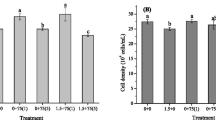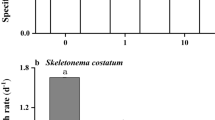Abstract
Most aquatic environments are suffering from microplastic pollution, which poses a threat to the physiological and ecological characteristics of aquatic animals. The phospholipid hydroperoxide glutathione peroxidase gene (PHGPx) has an important function in the antioxidative defense of organisms. Here, we revealed for the first time that the full-length cDNA of PHGPx in Brachionus calyciflorus was 817 bp long and contained a 512 bp open reading frame. B. calyciflorus was exposed to 0 (control), 1 × 104, 1 × 105, 1 × 106, and 1 × 107 particles mL−1 polystyrene (particle size: 1 µm). Specific growth rate (SGR); reproductive rate (R); superoxide dismutase (SOD), catalase (CAT), and PHGPx activities; manganese superoxide dismutase (MnSOD), copper and zinc superoxide dismutase (CuZnSOD), CAT, and PHGPx expression; and reactive oxygen species (ROS) levels were investigated. Our results showed that polystyrene enhanced ROS production. SGR, R, PHGPx activity, and PHGPx expression decreased with the increase in polystyrene concentrations. SOD and CAT activities and MnSOD, CuZnSOD, and CAT expression levels increased upon exposure to 1 × 104–1 × 106 particles mL−1 polystyrene but decreased under exposure to 1 × 107 particles mL−1 polystyrene. These results revealed that PHGPx, MnSOD, CuZnSOD, and CAT expression regulates antioxidant enzyme activities, which are involved in the PHGPx-associated antioxidant defense of rotifers in response to polystyrene.






Similar content being viewed by others
References
ASTM (2001) Standard guide for acute toxicity tests with the rotifer Brachionus. Annual book of ASTM standards, water and environmental technology, vol. 1105. Biological effects and environmental fates. American Society for Testing and Materials, West Conshohocken
Avio CG, Gorbi S, Milan M, Benedetti M, Fattorini D, d’Errico G, Pauletto M, Bargelloni L, Regoli F (2015) Pollutants bioavailability and toxicological risk from microplastics to marine mussels. Environ Pollut 198:211–222
Backhaus T, Wagner M (2020) Microplastics in the environment: much ado about nothing? A Debate. Glob Chall 4:1900022
Batel A, Linti F, Scherer M, Erdinger L, Braunbeck T (2016) Transfer of benzo[a]pyrene from microplastics to Artemia nauplii and further to zebrafish via a trophic food web experiment: CYP1A induction and visual tracking of persistent organic pollutants. Environ Toxicol Chem 35:1656–1666
Bradford MM (1976) A rapid and sensitive method for the quantitation of microgram quantities of protein utilizing the principle of protein-dye binding. Anal Biochem 72:248–254
Chen JC, Chen MY, Fang C, Zheng RH, Jiang YL, Zhang YS, Wang KJ, Bailey C, Segner H, Bo J (2020) Microplastics negatively impact embryogenesis and modulate the immune response of the marine medaka Oryzias melastigma. Mar Poll Bull 158:111349
De Almeida EA, Miyamoto S, Bainy ACD, De Medeiros MHG, Di Mascio P (2004) Protective effect of phospholipid hydroperoxide glutathione peroxidase (PHGPx) against lipid peroxidation in mussels perna exposed to different metals. Mar Poll Bull 49:386–392
Eriksen M, Mason S, Wilson S, Box C, Zellers A, Edwards W, Farley H, Amato S (2013) Microplastic pollution in the surface waters of the Laurentian great lakes. Mar Pollut Bull 77:177–182
Foley CJ, Feiner ZS, Malinich TD, Höök TO (2018) A meta-analysis of the effects of exposure to microplastics on fish and aquatic invertebrates. Sci Total Environ 631–632:550–559
Horn DA, Granek EF, Steele CL (2020) Effects of environmentally relevant concentrations of microplastic fibers on Pacific mole crab (Emerita analoga) mortality and reproduction. Limnol Oceanogr Lett 5:74–83
Horton AA, Walton A, Spurgeon DJ, Lahive E, Svendsen C (2017) Microplastics in freshwater and terrestrial environments: evaluating the current understanding to identify the knowledge gaps and future research priorities. Sci Total Environ 586:127–141
Imai H, Nakagawa Y (2003) Biological significance of phospholipid hydroperoxide glutathione peroxidase (PHGPx, GPx4) in mammalian cells. Free Radical Biol Med 34:145–169
Iwaoka M, Katakura A, Mishima J, Ishihara Y, Kunwar A, Priyadarsini KI (2015) Mimicking the lipid peroxidation inhibitory activity of phospholipid hydroperoxide glutathione peroxidase (GPx4) by using fatty acid conjugates of a water-soluble selenolane. Molecules 20:12364–12375
Jeong CB, Won EJ, Kang HM, Lee MC, Hwang DS, Hwang UK, Zhou B, Souissi S, Lee SJ, Lee JS (2016) Microplastic size-dependent toxicity, oxidative stress induction, and p-JNK and p-p38 activation in the monogonont rotifer (Brachionus koreanus). Environ Sci Technol 50:8849–8857
Lampert W, Trubetskova I (1996) Juvenile growth rate as a measure of fitness in Daphnia. Funct Ecol 10:631–635
Lasee S, Maurício J, Thompson WA, Karnjanapiboonwong A, Kasumba J, Subbiah S, Morse A, Anderson TA (2017) Microplastics in a freshwater environment receiving treated wastewater effluent. Integr Environ Assess Manag 13:528–532
Lee KW, Shim WJ, Kwon OY, Kang JH (2013) Size-dependent effects of micro polystyrene particles in the marine copepod Tigriopus japonicus. Environ Sci Technol 47:11278–11283
Li F, Wang P, Zhao C, Bao W, Qiu L (2017) Cloning and characterization of PHGPx and its synergistic role with p53 in mediating stress in Penaeus monodon. Fish Shellfish Immunol 71:380–392
Liang Y, Chen X, Lu X, Jin S, Min Y, Yang J (2017) Combined effects of microcystin and nitrite on the growth, lipid peroxidation, and antioxidant responses of the freshwater rotifer Brachionus calyciflorus. Aquat Toxicol 192:78–88
Liang Y, Shao L, Jiang Q, Yang J (2020) Changes in the life-cycle parameters and glutathione-related antioxidant defense system of rotifer Brachionus calyciflorus under the combined stress of microcystin-LR and ammonia. Aquat Ecol 54:243–256
Liu Z, Cai M, Yu P, Chen M, Wu D, Zhang M, Zhao Y (2018) Age-dependent survival, stress defense, and AMPK in Daphnia pulex after short-term exposure to a polystyrene nanoplastic. Aquat Toxicol 204:1–8
Liu Z, Yu P, Cai M, Wu D, Zhang M, Huang Y, Zhao Y (2019) Polystyrene nanoplastic exposure induces immobilization, reproduction, and stress defense in the freshwater cladoceran Daphnia pulex. Chemosphere 215:74–81
Livak KJ, Schmittgen TD (2001) Analysis of relative gene expression data using real-time quantitative PCR and the 2−ΔΔCt method. Methods 25:402–408
Manfra L, Rotini A, Bergami E, Grassi G, Faleri C, Corsi I (2017) Comparative ecotoxicity of polystyrene nanoparticles in natural seawater and reconstituted seawater using the rotifer Brachionus plicatilis. Ecotox Environ Safe 145:557–563
Mattsson K, Hansson LA, Cedervall T (2015) Nano-plastics in the aquatic environment. Environ Sci Process Impacts 17:1712–1721
Messinetti S, Mercurio S, Parolini M, Sugni M, Pennati R (2018) Effects of polystyrene microplastics on early stages of two marine invertebrates with different feeding strategies. Environ Pollut 237:1080–1087
Moore CJ, Lattin GL, Zellers AF (2011) Quantity and type of plastic debris flowing from two urban rivers to coastal waters and beaches of Southern California. J Integr Coast Zone Manag 11:65–73
Ogonowski M, Schur C, Jarsen A, Gorokhova E (2016) The effects of natural and anthropogenic microparticles on individual fitness in Daphnia magna. PloS One 11:e0155063
Pacitti D, Wang T, Page MM, Martin SAM, Sweetman J, Feldmann J, Secombes CJ (2013) Characterization of cytosolic glutathione peroxidase and phospholipid-hydroperoxide glutathione peroxidase genes in rainbow trout (Oncorhynchus mykiss) and their modulation by in vitro selenium exposure. Aquat Toxicol 130–131:97–111
Park JC, Han J, Lee MC, Seo JS, Lee JS (2017) Effects of triclosan (TCS) on fecundity, the antioxidant system, and oxidative stress-mediated gene expression in the copepod Tigriopus japonicas. Aquat Toxicol 189:16–24
Peng G, Xu P, Zhu B, Bai M, Li D (2018) Microplastics in freshwater river sediments in Shanghai, China: a case study of risk assessment in mega-cities. Environ Pollut 234:448–456
Rehse S, Kloas W, Zarfl C (2016) Short-term exposure with high concentrations of pristine microplastic particles leads to immobilization of Daphnia magna. Chemosphere 153:91–99
Rochman CM, Brookson C, Bikker J, Djuric N, Earn A, Bucci K, Athey S, Huntington A, Mcllwraith H, Munno K, De Frond H, Kolomijeca A, Erdle L, Grbic J, Bayoumi M, Borrelle SB, Wu T, Santoro S, Werbowski LM, Zhu X, Giles RK, Hamilton BM, Thaysen C, Kaura A, Klasios N, Ead L, Kim J, Sherlock C, Ho A, Hung C (2019) Rethinking microplastics as a diverse contaminant suite. Environ Toxicol Chem 38:703–711
Shah JA, Pandit AK, Shah GM (2015) A research on rotifers of aquatic ecosystems of Kashmir Himalaya for documentation and authentication. Proc Natl Acad Sci India Sect B Biol Sci 85:13–19
Snell TW (1980) Blue-green algae and selection in rotifer populations. Oecologia 46:343–346
Snell TW, Janssen CR (1995) Rotifers in ecotoxicology: a review. Hydrobiologia 313(314):231–247
Snell TW, Joaquim-Justo C (2007) Workshop on rotifers in ecotoxicology. Hydrobiologia 593:227–232
Snell TW, Moffat BD (1992) A 2-d life cycle test with the rotifer Brachionus calyciflorus. Environ Toxicol Chem 11:1249–1257
Strungaru SA, Jijie R, Nicoara M, Plavan G, Faggio C (2019) Micro-(nano) plastics in freshwater ecosystems: Abundance, toxicological impact and quantification methodology. Trends Anal Chem 110:116–128
Sun X, Chen B, Li Q, Liu N, Xia B, Zhu L, Qu K (2018) Toxicities of polystyrene nano- and microplastics toward marine bacterium Halomonas alkaliphila. Sci Total Environ 642:1378–1385
Sun Y, Xu W, Gu Q, Chen Y, Zhou Q, Zhang L, Gu L, Huang Y, Lyu K, Yang Z (2019) Small-sized microplastics negatively affect rotifers: changes in the key life-history traits and rotifer-Phaeocystis population dynamics. Environ Sci Technol 53:9241–9251
Sussarellu R, Suquet M, Thomas Y, Lambert C, Fabioux C, Pernet MEJ, Le Goïc N, Quillien V, Mingant C, Epelboin Y, Corporeau C, Guyomarch J, Robbens J, Paul-Pont I, Soudant P, Huvet A (2016) Oyster reproduction is affected by exposure to polystyrene microplastics. Proc Natl Acad Sci 113:2430–2435
Tang J, Wang X, Yin J, Han Y, Yang J, Lu X, Xie T, Akbar S, Lyu K, Yang Z (2019) Molecular characterization of thioredoxin reductase in waterflea Daphnia magna and its expression regulation by polystyrene microplastics. Aquat Toxicol 208:90–97
Uye S (1982) Length-weight relationships of important zooplankton from the inland sea of Japan. J Oceanogr Soc Jpn 38:149–158
Wang H, Tang X, Sha J, Chen H, Sun T, Wang Y (2015) The reproductive toxicity on the rotifer Brachionus plicatilis induced by BDE-47 and studies on the effective mechanism based on antioxidant defense system changes. Chemosphere 135:129–137
Wen B, Jin SR, Chen ZZ, Gao JZ, Liu YN, Liu JH, Feng XS (2018) Single and combined effects of microplastics and cadmium on the cadmium accumulation, antioxidant defense and innate immunity of the discus fish (Symphysodon aequifasciatus). Environ Pollut 243:462–471
Yagi K, Shidoji Y, Komura S, Kojima H, Ohishi N (1998) Dissipation of mitochondrial membrane potential by exogenous phospholipid monohydroperoxide and protection against this effect by transfection of cells with phospholipid hydroperoxide glutathione peroxidase gene. Biochem Biophys Res Commun 245:528–533
Yang J, Dong S, Jiang Q, Kuang T, Huang W, Yang J (2013) Changes in expression of manganese superoxide dismutase, copper and zinc superoxide dismutase and catalase in Brachionus calyciflorus during the aging process. PLoS One 8:e57186
Yang D, Shi H, Li I, Li J, Jabeen K, Kolandhasamy P (2015) Microplastic pollution in table salts from China. Environ Sci Technol 49:13622–13627
Yu P, Liu Z, Wu D, Chen M, Lv W, Zhao Y (2018) Accumulation of polystyrene microplastics in juvenile Eriocheir sinensis and oxidative stress effects in the liver. Aquat Toxicol 200:28–36
Zhang Y, He Y, He L, Zong HY, Cai GB (2015) Molecular cloning and characterization of a phospholipid hydroperoxide glutathione peroxidase gene from a blood fluke Schistosoma japonicum. Mol Biochem Parasit 142:1595–1604
Acknowledgements
This work was supported by the Natural Science Foundation of the Jiangsu Higher Education Institutions of China (Grant number: 19KJB180020), the Fund of Fujian Provincial Key Laboratory of Marine Ecological Conservation and Restoration (Grant number: EPR2020004), and the Startup Foundation for Introducing Talent of NUIST (Grant numbers: 2018r040 and 2020r062).
Author information
Authors and Affiliations
Corresponding authors
Ethics declarations
Conflict of interest
The authors declare that they do not have any conflict of interest.
Ethical approval
All applicable international, national, and institutional guidelines for the use of animals were followed by the authors.
Additional information
Publisher's Note
Springer Nature remains neutral with regard to jurisdictional claims in published maps and institutional affiliations.
Handling Editor: Télesphore Sime-Ngando
Rights and permissions
About this article
Cite this article
Liang, Y., Yang, X., Wang, Y. et al. Influence of polystyrene microplastics on rotifer (Brachionus calyciflorus) growth, reproduction, and antioxidant responses. Aquat Ecol 55, 1097–1111 (2021). https://doi.org/10.1007/s10452-021-09885-y
Received:
Accepted:
Published:
Issue Date:
DOI: https://doi.org/10.1007/s10452-021-09885-y




